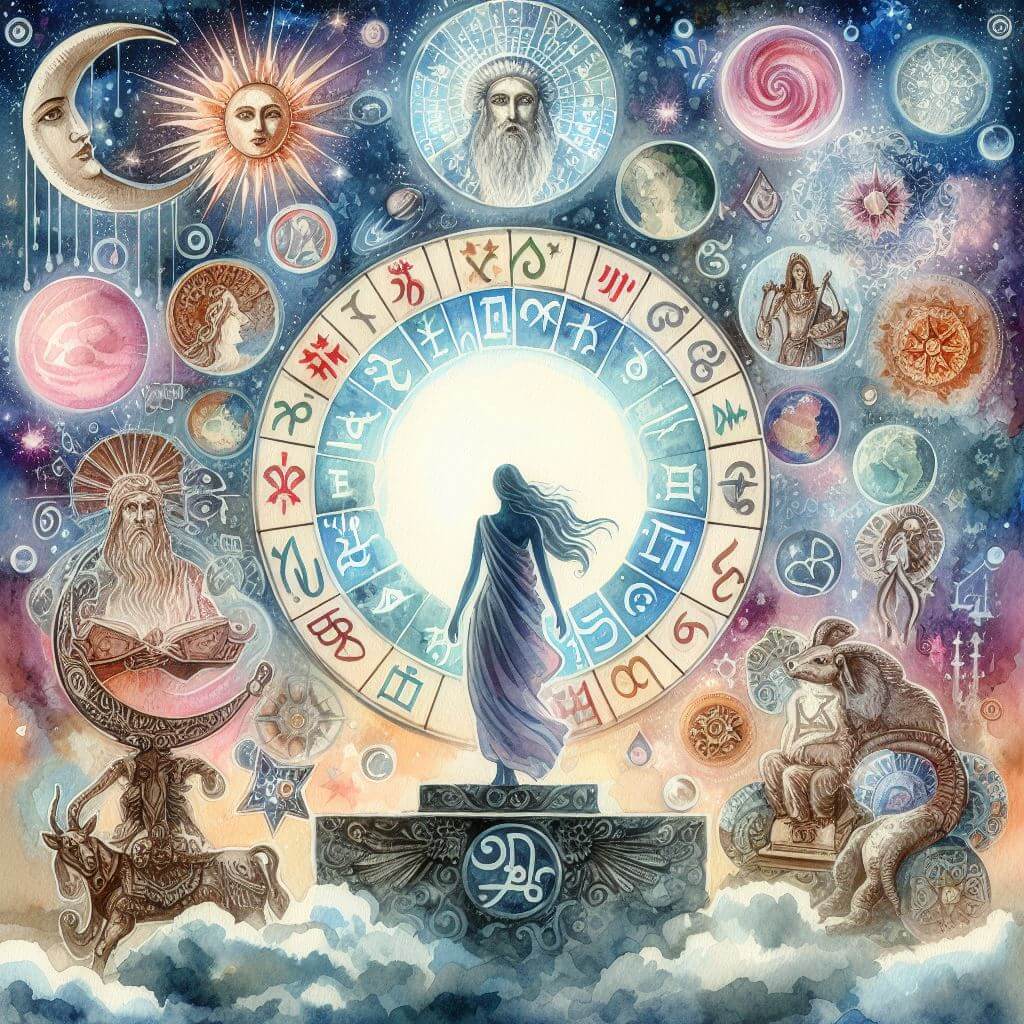
Astrology, a captivating field that bridges the gap between the cosmos and our personal lives, might seem daunting at first. Yet, the simplicity beneath its complex exterior is what makes it so fascinating. Let’s delve into the world of astrology, simplified for beginners.
Astrology Simplified: Understanding the Basics
Astrology is more than just horoscopes in the daily newspapers. It’s a profound system that mirrors the universe’s rhythm and reflects human life. It’s a cosmic language, translating the universe’s messages through the positions and movements of celestial bodies.
Astrology is based on three fundamental components: planets, signs, and houses. Planets represent different facets of life, signs depict unique energy patterns, and houses correspond to life areas or stages. When these elements align, they form a unique astrological profile, your natal chart, a celestial snapshot of the universe at your birth moment.
Planets: The Cosmic Actors
In the vast cosmic theatre of astrology, the planets play the leading roles. Each one symbolizes a different facet of life, a part of our personality, or a specific life event. These cosmic actors, with their unique traits and characteristics, bring to life the celestial drama.
For instance, Venus, named after the Roman goddess of love and beauty, is the planetary symbol of love, beauty, harmony, and affection in astrology. But Venus is much more than just love and beauty. It also represents our approach to relationships, the way we attract others and our desire for harmony and peace. It symbolizes our values and what we appreciate in life. When you look at Venus in a natal chart, it can give you clues about a person’s love style, their sense of aesthetics, and what they find comforting.
Signs: The Cosmic Filters
If the planets are the actors in the celestial theatre, then the zodiac signs are the costumes they wear and the roles they play. Each of the twelve zodiac signs has its unique characteristics, strengths, and weaknesses, which shape and color the expression of the planetary actors.
Zodiac signs are like the lenses through which the planets view the world. They filter the planetary energies and mold them into specific behaviors, patterns, and tendencies. For example, Mars, the planet of action, wearing the costume of Aries, a fire sign, might manifest as assertiveness, raw energy, courage, and pioneering spirit. But when Mars dons the garb of Libra, an air sign, it expresses itself through a drive for justice, balance, and intellectual pursuits.
Houses: The Cosmic Stages
The twelve houses in astrology are the stages upon which the cosmic drama unfolds. They represent different spheres of life, from the personal to the collective, the inner world to the outer world. Each house corresponds to a particular life area, setting the scene for the planetary actors to perform.
For instance, the First House, also known as the Ascendant or Rising Sign, is about self-identity, appearance, and first impressions. It’s the stage setting for the beginning of life’s journey, representing our immediate environment and how we project ourselves to the world. The planet or planets residing in this house, along with the sign on the house cusp, greatly influences our approach to these life areas, shaping our personality, physical appearance, and personal outlook.
In a simplified world of astrology, understanding these three core components – the planets, the signs, and the houses – is the first step on your cosmic journey.

The Natal Chart: Your Cosmic Blueprint
The natal chart, also known as the birth chart, is the heart of astrology for beginners. It’s a celestial snapshot of the exact moment of your birth, illustrating where each planet was in the zodiac and what house it occupied. This chart is your cosmic blueprint, revealing insights about your personality, relationships, career, and overall life path.
To acquire your natal chart, you can use online tools by inputting your exact date, time, and location of birth. Alternatively, you may consult with a professional astrologer for a more detailed interpretation.
How to Read Your Natal Chart
Reading a natal chart might seem complicated, but don’t worry, here’s a step-by-step guide:
Identify Your Sun Sign: The Sun represents your core personality, ego, and identity. Its sign indicates your general life path and the traits you’re learning to embody.
Spot Your Moon Sign: The Moon depicts your emotional inner world, instincts, and what makes you feel secure. Its sign indicates how you process emotions, your intuitive responses, and what you need for emotional comfort.
Find Your Rising Sign: Also known as the Ascendant, the Rising sign is the zodiac sign that was ascending on the eastern horizon at your birth time. It represents your first impressions, physical appearance, and how you approach the world.
Locate Your Planetary Placements: Each planet in your natal chart represents different life facets. For example, Mars illustrates how you assert yourself, while Jupiter shows where you experience luck and abundance.
Discover Your House Placements: The houses in your natal chart represent different life areas. Planets in these houses can indicate where you’ll experience the planet’s energy in your life. For instance, Venus in the Seventh House might suggest a love for partnership and harmony in relationships.
Look at Your Aspects: Aspects are the angles between planets on the natal chart. They depict the relationships between different parts of your personality and can indicate harmony or tension. For example, a trine (120°) is generally favorable, while a square (90°) might suggest a challenge.
Understanding your natal chart is like having a roadmap to your life. It’s a tool for self-discovery, helping you understand your strengths, challenges, and potential.
Practical Astrology Simplified: Applying Your Knowledge
You’ve begun to understand the basics of astrology and even read your natal chart. Now, how do we take this cosmic knowledge and apply it to our everyday lives? Here’s how you can make astrology practical:
Self-Understanding and Personal Growth: Your natal chart can provide insights about your personality traits, strengths, and weaknesses. You can use this knowledge for self-improvement and personal growth. For instance, if your Mars is in Cancer, you may express your assertiveness in a protective, nurturing way. Knowing this can help you understand your natural reaction patterns and work on areas for growth.
Relationship Dynamics: Understanding not just your natal chart, but others as well, can shed light on relationship dynamics. For instance, if your Venus (planet of love) is in Gemini, and your partner’s Venus is in Capricorn, it could explain why you crave variety in love, while your partner seeks stability.
Career Guidance: Astrology can provide guidance about your professional life. For example, having a strong Saturn (planet of discipline and structure) might suggest you’d thrive in a career requiring organization and responsibility.
Timing and Planning: Astrology can also be a tool for planning and timing. For example, Mercury Retrograde, a period when the planet Mercury appears to move backward in the sky, is traditionally a time to review and reassess, rather than start new projects.
Greater Life Understanding: On a broader scale, understanding astrology can help you make sense of life events and cycles. It provides a framework for understanding the ups and downs of life from a larger cosmic perspective.

Astrology for Dummies: Beyond the Basics
While we’ve covered the fundamentals of astrology, there’s always more to explore. Here are some elements we didn’t touch on before, but are significant in deepening your understanding of astrology:
The Nodes of the Moon: The North Node and South Node are points in your natal chart that represent your life’s purpose (North Node) and past lives (South Node). Understanding these points can provide insight into your spiritual journey and life lessons.
Retrograde Planets: When a planet is in retrograde in your natal chart, it suggests a need to revisit and learn lessons related to that planet’s qualities. For example, Mercury Retrograde in your birth chart might indicate a need to learn how to communicate more effectively.
The Midheaven and Nadir: The Midheaven (MC) and Nadir (IC) are points that represent your public image/career (MC) and your private life/home (IC). They can provide insight into your career path and home life.
Progressed Chart: A progressed chart is a powerful tool that reveals how you’ve evolved over time. It’s calculated by moving your natal chart’s planets and points approximately one degree per year of your life.
Synastry and Composite Charts: These are methods used in relationship astrology. Synastry overlays two natal charts to see how the individuals interact, while a composite chart creates a single chart that represents the relationship itself.
Transits: Transits are current planetary movements and their relationships to your natal chart. They can help you understand current moods, trends, and events in your life.
Astrology and Health: Each zodiac sign is associated with certain parts of the body, and understanding these connections can provide insight into potential health strengths and weaknesses.
Embracing Astrology for Self-Discovery and Life Navigation
Remember, astrology is a vast field, and this is just the beginning. Whether you delve into the intricacies of astrological theory or keep it practical with daily horoscopes, astrology offers a rich language for understanding ourselves and our place in the cosmos.
In the world of astrology, the cosmos is not just a vast expanse of space, but a mirror reflecting our lives. Astrology is a tool for self-discovery, understanding others, and navigating life more smoothly. Whether you’re using it for personal insights, relationship dynamics, or career guidance, astrology can provide a unique lens through which to view your life.



